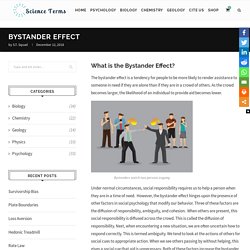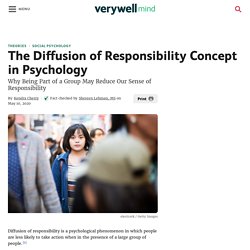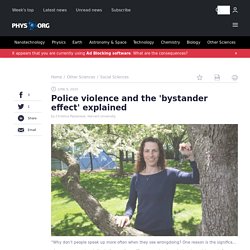

" What Is the Bystander Effect? If you witnessed an emergency happening right before your eyes, you would certainly take some sort of action to help the person in trouble, right?

While we might all like to believe that this is true, psychologists suggest that whether or not you intervene might depend upon the number of other witnesses present. What Is the Bystander Effect? The term bystander effect refers to the phenomenon in which the greater the number of people present, the less likely people are to help a person in distress. When an emergency situation occurs, observers are more likely to take action if there are few or no other witnesses.
Being part of a large crowd makes it so no single person has to take responsibility for an action (or inaction). Bystander effect. Bystander effect, the inhibiting influence of the presence of others on a person’s willingness to help someone in need.

Research has shown that, even in an emergency, a bystander is less likely to extend help when he or she is in the real or imagined presence of others than when he or she is alone. Moreover, the number of others is important, such that more bystanders leads to less assistance, although the impact of each additional bystander has a diminishing impact on helping. Investigations of the bystander effect in the 1960s and ’70s sparked a wealth of research on helping behaviour, which has expanded beyond emergency situations to include everyday forms of helping.
By illuminating the power of situations to affect individuals’ perceptions, decisions, and behaviour, study of the bystander effect continues to influence the course of social psychological theory and research. Bystander intervention Get exclusive access to content from our 1768 First Edition with your subscription. Bystander Effect - Definition, Examples and Experiment. The bystander effect is a tendency for people to be more likely to render assistance to someone in need if they are alone than if they are in a crowd of others.

As the crowd becomes larger, the likelihood of an individual to provide aid becomes lower. Bystanders watch two persons arguing Under normal circumstances, social responsibility requires us to help a person when they are in a time of need. However, the bystander effect hinges upon the presence of other factors in social psychology that modify our behavior. Three of these factors are the diffusion of responsibility, ambiguity, and cohesion. The Bystander Effect and Why You're a Horrible Person. Bystander Effect: What Is It and What You Can Do About It. What the bystander effect looks like A little after 3 a.m. on March 13, 1964, Catherine “Kitty” Genovese parked her car and walked to her apartment in Queens, New York, after finishing her shift as a bar manager.
Serial killer Winston Moseley was out to victimize someone that night. Genovese became his target. When he followed her, she ran. As Moseley reached her and began stabbing her with a hunting knife, Genovese screamed, “Oh, my God, he stabbed me! When lights in surrounding apartments flipped on and one man called out his window, the attacker ran and hid in the shadows. There was widespread public condemnation of the witnesses who did not come to Kitty Genovese’s aid. How Diffusion of Responsibility Affects Group Behavior. Diffusion of responsibility is a psychological phenomenon in which people are less likely to take action when in the presence of a large group of people.1 For example, imagine that you are in a large city on a bustling street.

You notice a man fall to the ground and start convulsing as if having a seizure. Many people turn and look at the man, but no one moves to help or call for medical assistance. 10 Notorious Cases of the Bystander Effect. Why we still look away: Kitty Genovese, James Bulger and the bystander effect.
More than half a century later, the death of Kitty Genovese continues to remind us of the disconnect between what we believe about ourselves and how we really act under pressure.

The murder of the 28-year-old outside her apartment in the Queens neighborhood of Kew Gardens in the early morning of 13 March 1964 rippled through New York City and around the world. How could a young, independent woman who lived on her own terms be so easily struck down? How could so many neighbors look on and turn away as she was stabbed repeatedly on the street and in her apartment building? What did that collective inability to act reveal about ourselves, our communities, and our belief systems? Genovese’s killer, Winston Moseley, died in prison this week, bringing the case and its implications back into the spotlight. Two weeks after her murder, Rosenthal assigned a story with the damning headline: “Thirty-Seven Who Saw Murder Didn’t Call Police.” Take the story of Hugo Alfredo Tale-Yax. 20 YEARS AFTER THE MURDER OF KITTY GENOVESE, THE QUESTION REMAINS: WHY? But New Yorkers were traumatized as well.

It crystallized what people were only beginning to feel about urban life in America: the anonymity, the lack of human contact, the feeling of not being able to control one's environment. ''The case touched on a fundamental issue of the human condition, our primordial nightmare,'' Dr. Milgram said. ''If we need help, will those around us stand around and let us be destroyed or will they come to our aid? Are those other creatures out there to help us sustain our life and values or are we individual flecks of dust just floating around in a vacuum? '' Police violence and the 'bystander effect' explained. Since George Floyd died after police officer Derek Chauvin knelt on his neck for almost nine minutes on May 25, demonstrators across the country have gathered to protest police actions against African Americans.

While most of the protests were calm, in several cities police officers have used force against demonstrators and journalists under the justification of crowd control. The sight of officers in riot gear beating marchers, firing rubber bullets and chemical- or pepper-based irritants, and shoving activists has reignited questions about accepted practic Francesca Gino, Tandon Family Professor of Business Administration at Harvard Business School, studies leadership, the psychology of decision-making, and organizational behavior. She has written about how an organization can develop a culture that can turn harmful to its own people, to the success of its mission, and to its own reputation. Q&A: Francesca Gino This is not a story in isolation. This document is subject to copyright. George Floyd: How race may affect what bystanders can do for detainees. Surveillance video in Minneapolis shows the first moments of George Floyd's police interaction.

USA TODAY In the videos, they are faceless voices, off camera, trying to intervene. They say things like “get off his neck,” or “he’s a human,” or “he’s dying.” George Floyd, a 46-year-old black man, died Monday when a white Minneapolis police officer knelt on his neck for several minutes after he was detained. It was bystanders – the owners of those voices – who shed light with their viral video recordings of yet another deeply disturbing incident of excessive force levied against a minority in police custody. As people in Minneapolis and across the U.S. continue to protest the killing, Floyd’s death has provoked even more questions about the role bystanders should play when caught in similar situations. History of complaints: Minneapolis police at center of George Floyd’s death had 13 combined complaints Those placed in custody are supposed to wield some protections under the Constitution. The Bystander Effect and Altruism.
Learning Objectives Explain the factors that influence human altruism, including reciprocal altruism and diffusion of responsibility.

Go to YouTube and search for episodes of “Primetime: What Would You Do?” You will find video segments in which apparently innocent individuals are victimized, while onlookers typically fail to intervene. The events are all staged, but they are very real to the bystanders on the scene. The entertainment offered is the nature of the bystanders’ responses, and viewers are outraged when bystanders fail to intervene. Figure 1. We Are All Bystanders. For more than 40 years, Peggy Kirihara has felt guilty about Stewart.

Peggy liked Stewart. They went to high school together. Their fathers were friends, both farmers in California’s Central Valley, and Peggy would always say “hi” when she passed Stewart in the hall. Yet every day when Stewart boarded their school bus, a couple of boys would tease him mercilessly. And every day, Peggy would just sit in her seat, silent. “I was dying inside for him,” she said. Peggy still can’t explain why she didn’t stick up for Stewart. . © Damian King But perhaps most surprising—and distressing—to Peggy is that she considers herself an assertive and moral person, yet those convictions aren’t backed up by her conduct on the bus.
Researchers Found the ‘Bystander Effect’ in 5-Year-Olds. Photo: MGM/The Kobal Collection. ‘Bystander effect’ and sexual assault: What the research says. Courtesy of Heather Hensman Kettrey, Clemson University and Robert Marx, Vanderbilt University Sexual assault, pushed into public conversation by the #MeToo movement, once again dominates the U.S. news cycle. Supreme Court nominee Brett Kavanaugh faces allegations that he sexually assaulted professor Christine Blasey Ford, a former high school classmate.
The allegations have led to a number of important questions regarding victim testimony, the veracity of memory and the justice system in America. However, as social scientists who study sexuality and violence, we found ourselves asking a different question: Where were Kavanaugh and Ford’s classmates during this alleged incident? Bystander effect: Famous psychology result could be completely wrong. By Grace Browne SolStock/Getty If you were being attacked, would anyone stop to help you?
A famous result in psychology known as the bystander effect says probably not, but now a review of real-life violent situations says this commonly held view may be wrong. How to Overcome the Bystander Effect. Psychologists have long been interested in exactly why and when we help other people. There has also been a tremendous amount of interest in the reasons why we sometimes don't help others. How to Break the Bystander Effect. They could have left it to someone else. An Army veteran blocked a shooter in Oregon from entering his classroom. Three friends on a high-speed train from Paris to Amsterdam helped stop a gunman wielding an AK-47. This past spring, an Army captain in North Carolina pulled a couple to safety after a fiery car crash.
Overcoming the Bystander Effect. Have you ever been a hero? The Bystander Effect - You Can Break the Cycle. Is the Bystander Effect Real? The Science of Empathy. Are We Victims Of "Bystander Effect"?